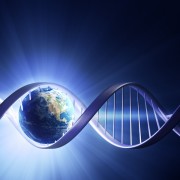Protein molecules
Biopolymers such as nucleic acids (DNA and RNA) and proteins have been charged by natural evolution with the task of storing, transmitting and transforming genetic information of living matter.
In particular proteins are the macromolecules which perform most of the biochemical and biomechanical activities of organisms. Proteins, for instance, provide the building blocks of cells and tissues, they are involved in control and regulation of cellular cycles, in enzymatic catalysis, proteins are at the basis of muscle contractions and constitute part of the immunitary defence, etc… The list of biological functions which proteins are involved in is extremely long and rapidly increasing with the research advances.
Biologists use to classify proteins in terms of primary structure (amino acid sequence), secondary structure (regions of alpha-helices, beta-sheets, coils and turns) tertiary structure (3-dimensional spatial arrangement of atoms).
In particular proteins are the macromolecules which perform most of the biochemical and biomechanical activities of organisms. Proteins, for instance, provide the building blocks of cells and tissues, they are involved in control and regulation of cellular cycles, in enzymatic catalysis, proteins are at the basis of muscle contractions and constitute part of the immunitary defence, etc… The list of biological functions which proteins are involved in is extremely long and rapidly increasing with the research advances.
Biologists use to classify proteins in terms of primary structure (amino acid sequence), secondary structure (regions of alpha-helices, beta-sheets, coils and turns) tertiary structure (3-dimensional spatial arrangement of atoms).
The remarkable property of proteins is certainly their spontaneous collapse, under appropriate physiological conditions, onto a specific three-dimensional structure (native state) directly related to biological functions. This complex dynamical process is termed protein folding and its full elucidation still remains an unsolved issue of modern science. The role of native states is so critical to protein functions, that any factor preventing a protein from reaching its corresponding native state brings organisms at risk of severe diseases. This only reason is sufficient to justify the paramount importance of the study of protein folding to biomedical applications.


